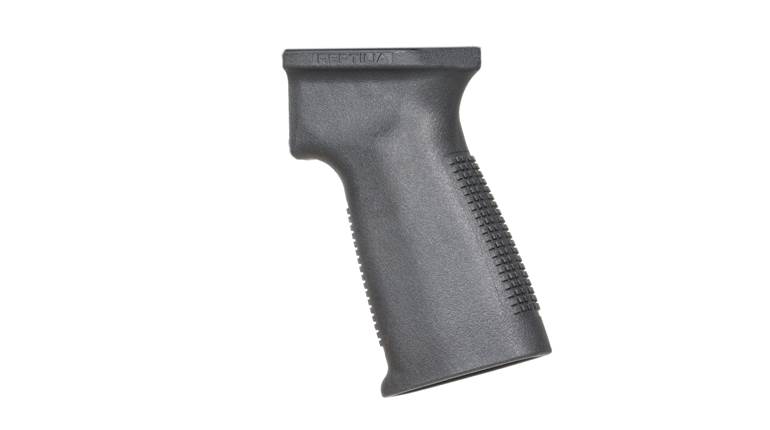
For many, the name James River Armory likely brings to mind beautifully restored and produced U.S. military classics like M1 Garands and M1903 series rifles as well as new classics like the company’s M1 Carbines and M14 rifles. Interestingly, James River Armory began its life in 2002 catering to Civil War firearms fans by remanufacturing Italian imported reproductions to take them to the next level of authenticity and performance. It was the next stage for the company that took it into the realm of World War II through Vietnam-era firearms, offering completely refinished M1 Garands and Carbines.
As available supplies of these firearms began to dry up, around 2013 the company made the move to begin manufacturing firearms such as its M1 Carbines and M14 rifles (although it continues to offer the service of refinishing and restoring customer-provided Garands and Carbines back to what they describe as “arsenal reissue” condition).
But, this is not everything the company offers. In fact, at the time it introduced its new production M1 Carbine and M14 lines, James River Armory also introduced a new “AK Line” that combined demilled AK parts kits with the requisite number of 922r compliance parts needed to produce a U.S.-made, semi-automatic, civilian-legal version of these rifles. As is the nature of the surplus market, this line depends upon the availability of suitable parts kits for these builds, so the AK rifles that are or are not offered changes from time to time. Needless to say, if they are offering one you want, you should buy it when you see it.
AK History
Before we get started on our consideration of the James River Armory AKM, a brief history of the Kalashnikov family of Russian “AK” (Avtomat Kalasnikova) firearms may be in order. Mikhail Kalashnikov, the father of the AK, developed a good understanding of the need for a modern military rifle during his service against the Nazis in World War II. Recognizing the need for a compact, yet powerful firearm that combined the range of a rifle with the firepower of a submachine gun (SMG), he set about developing what would become what we know as the “AK-47,” which was adopted by the Soviet Army in 1949.
The select-fire AK fed from a detachable box magazine (in most cases holding 30 rounds), fired the then-new M43 cartridge (which we know as the 7.62x39 mm, first fielded in the earlier SKS carbine) and was as revolutionary a force as the Soviet regime that supported it. The result was exactly what Mr. Kalashnikov had intended; it effectively combined the firepower of an SMG with the relative range and power of a rifle (the 7.62x39 mm is considered to be an “intermediate cartridge” and begins to really lose steam past 300 to 400 meters).
In addition to its combat capabilities, Kalashnikov also designed the new AK to be cost-effective to produce. This was achieved through the use of sheet metal stampings to lower costs and keep the firearm as light as practical. While the first AKs produced did in fact feature stamped-steel receivers, performance problems with the rifles soon began to rear its ugly head (likely due to the Soviets’ relative lack of experience in sheet steel stampings). As a result, production was shifted to a milled-steel receiver as a stopgap measure. Although these did work, they were more costly and time-consuming to produce (as well as heavier). Obviously, this was not what Kalashnikov had in mind for his creation, and the desire to develop a workable stamped-steel receiver for the AK remained.
With later refinements and advancements in Soviet sheet steel production, by the late 1950s the Russians took another stab at a stamped receiver AK. That rifle, the Avtomat Kalashnikova Modernizirovanniy (AKM) was basically a “modernized” version of the AK that brought it more in line with Kalashnikov’s original vision. It is easily the most commonly seen variant of the AK around today.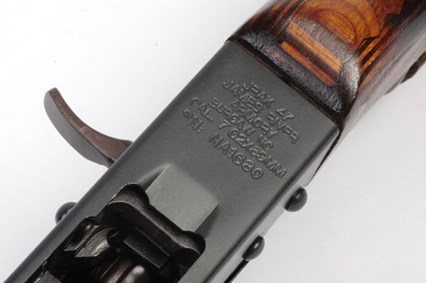
James River Armory located its receiver markings on the underside of the receiver to not detract from the looks of the rifle any more than necessary.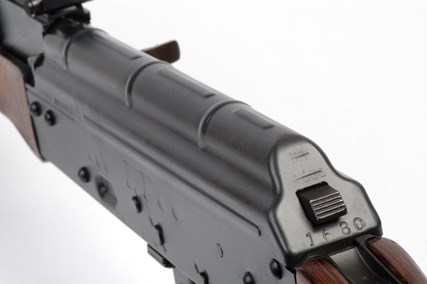
The rifle features a correct AKM-pattern top cover manufactured from sheet steel and featuring integral strengthening ribs.
In addition to its lightweight stamped steel receiver, the AKM also featured a thinner reinforced-rib sheet steel top cover and a laminated stock set for greater resistance to the elements. Additionally, a “slant” brake muzzle device was added to the rifle’s threaded muzzle. The brake features a 45-degree angle face and a slight rightward cant to help offset recoil for a right-handed shooter under full-automatic fire.
Russian Beauty
So, that brings us back to the James River Armory AK Line. In its vigilant search for usable AK kits for its projects, James River Armory managed to locate a small batch of true Russian AKM rifles produced by the Izhmash and Tula factories. These late 1960s-era rifles were in excellent condition, featured matching numbers, and obviously were a great source for a run of rifles from the company.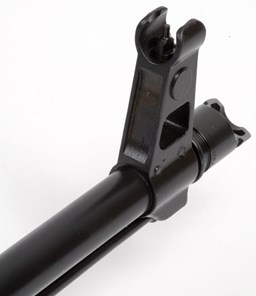
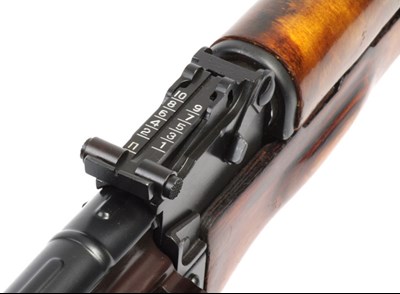
Left, the threaded muzzle is topped off with a U.S.-made slant brake. Note the post front sight, protected by heavy wings. Right, the rear sight of the rifle is a sliding tangent unit with a notch, optimistically ranged out to 1,000 meters.
To turn these kits into functioning rifles, James River Armory employed a newly manufactured stamped-steel receiver as well as five other 922r-compliant, U.S.-made parts (chrome-lined barrel, TAPCO trigger, hammer and disconnector, and a slant brake). The rest of the rifle is made up of the original Russian parts. James River Armory constructs its AK rifles in-house with its own AK gunsmith.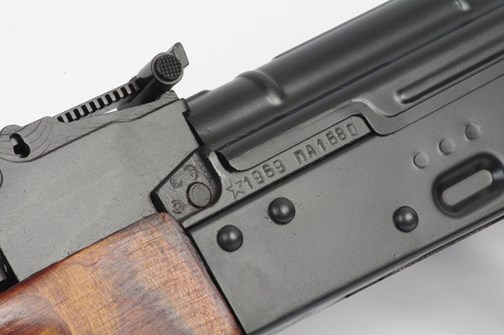
Note the Tula arsenal "star" marking on the trunnion as well as the "1969" year of manufacture.
Now, this Russian AKM is more than just the sum of its parts thanks to the attention to detail of James River Armory. The laminated stock set is refinished to bring it back up to its original condition, and rather than employing a simple coated finish on the metal, the company gave the rifle a more classic blued finish. The resulting rifle is a good approximation of a late-1960s AKM, and has the additional charm of being built from a true Russian parts kit.

The rifle came with the original laminated wood buttstock that was refinished as well as the original red bakelite pistol grip.
I recently picked up one of these Russian AKM rifles myself for my personal collection. I have long been a fan of AK-pattern firearms, yet I have very few Russian-based variants (and the ones I do are more modern 5.45x39 mm versions with polymer stock sets and features such as 90-degree gas blocks). I had really wanted to get a retro-style Russian 7.62x39 mm AKM, and this James River Armory rifle was just the ticket. I also lucked up and managed to get one of the more rare Tula kit-based builds.
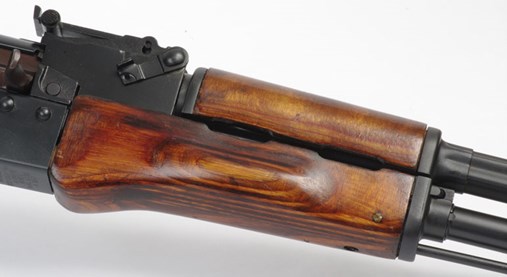
James River Armory refinished the laminate stock set that came with the Russian parts kit to bring out its beauty.
The subdued blue finish on the metal parts is evenly applied, and the stock set has a low-gloss lacquer finish on the wood that really brings out its beauty. I appreciate the fact that James River Armory clearly made an effort to keep the appearance of the rifle as original as possible. While they were required to swap out six parts to achieve 922r compliance, the company selected parts that did not detract from the original appearance of the rifle (for example, switching out parts such as the gas piston rather than something like the red bakelite pistol grip).
I took the rifle out to the range with a selection of 7.62x39 mm ammunition from Hornady, Century (Red Army Standard) and Wolf. As the rifle does not have a side-rail optic mount, I would be working with the basic (but usable) iron sights. For those not familiar with the AK’s system of operation, simplicity and reliability are paramount in the design. To load the rifle, you simply rock in a magazine (from front to back), disengage the large safety/dustcover lever by sweeping it down, and then pull back and release the reciprocating charging handle. It is now ready to fire.
The source of the AK’s reliability is twofold: One element is the nature of the rifle’s relatively loose tolerances, and the other is the long-stroke gas piston system. A large gas piston is attached directly to the bolt carrier, which results in a large mass of metal moving back and forth when the rifle cycles. These two qualities work together to make for extremely reliable firearms.
I set up a target at 100 yards and began putting the rifle through its paces, firing five, five-shot groups for accuracy. All three loads performed pretty consistently, with it showing a slight preference for the Hornady load. The best group with that load was 3.09”, with the average across all three loads being 3.76”. I then ran a few hundred rounds through the rifle to check for reliability. During the entire testing process, I did not have a single malfunction with the rifle, and all controls functioned smoothly (from magazine insertions and removals to operation of the safety).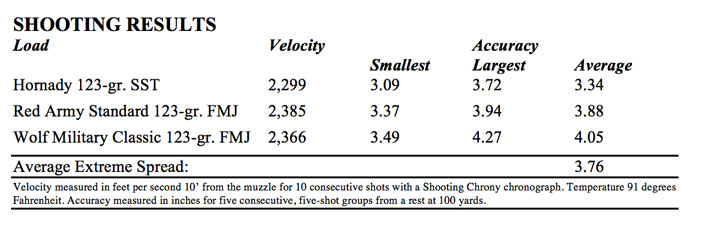
Unfortunately, due to the changing availability of AK parts kits, the Russian AKM is no longer available from James River Armory. However, be sure to keep an eye out on their site to see what new and interesting AK products they may have to offer in the future. Also, I have been informed that the company offers build services for those with their own AK parts kits who want them built into complete, civilian-legal rifles. For more information, call (910) 300-6462 or visit jamesriverarmory.com.
NRA Specifications
Chambering: 7.62x39 mm
Barrel: 16.25”
OA Length: 35.3”
Weight: 7 lbs., 4 oz.
Stock: Laminated wood
Sights: Post front, notch rear
Action: Long-stroke piston
Finish: Blued
Capacity: 30+1
MSRP: $1,200 (as tested)












